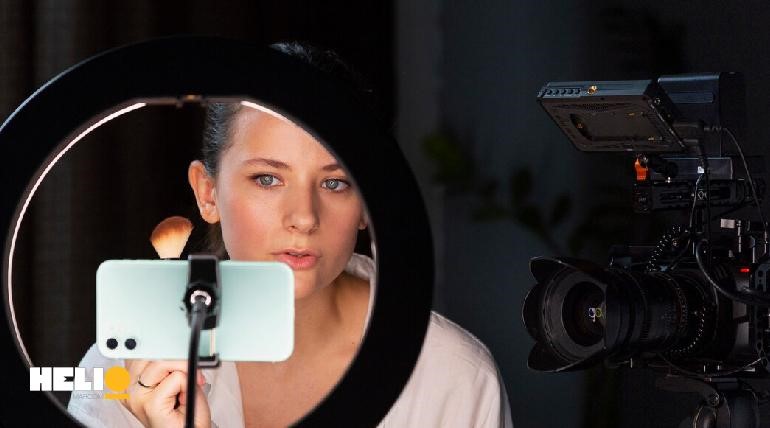In a world where the battle for consumer attention is fought mainly on digital landscapes, visual identity stands as the standard bearer for any brand worth its salt. Visual identity, often wrongly mixed up with a brand’s identity, is the face and message board of your endeavors. This blog post isn’t just about glitzy logos and attractive color schemes; it’s a deep dive into why the essence of your brand’s visual identity cannot be overlooked.
This guide, produced by the graphics design department at Helio, aims to further demystify the concept of visual identity and its paramount importance. It’s crucial to understand that visual identity extends beyond mere aesthetics; it encapsulates everything from your logo and color palette to your typography and imagery. These elements work in unison not just to make your brand recognizable but to weave a narrative that resonates with your audience on an emotional level. A well-conceived visual identity, often born out of creative concept development, translates your brand’s values, strengths, and uniqueness into a visual language that speaks to your audience, fostering a deeper connection and recognition.
What is Visual Identity and How it Differs from Brand Identity
Visual identity is the set of visual elements that brands use to make themselves instantly recognizable to their stakeholders. This includes your logo, color palette, typography, and imagery choices. It’s about keeping a consistent message, look, and feel across all platforms and touchpoints.
But wait, what about brand identity? Right next to ’emotional appeal,’ ‘brand identity’ seems to clutter the space with its intangible ring. The primary difference between brand identity and visual identity is that the latter is a component of the former. Where brand identity encapsulates everything that gives your brand a unique personality, visual identity is the visual part.
Understanding the Power of Visual Identity in the Market
If your brand was a person, visual identity would be the clothes it wears. Like any strong wardrobe, these visual elements aren’t picked randomly; instead, they are crafted to make an impression that lasts. What impression does your brand give? Whether it’s sophistication, trustworthiness, or friendliness, the choice of visuals plays a pivotal role. In an oversaturated market, a distinctive visual identity becomes the touchstone for customer remembrance and preference.
Delving into the Elements of Visual Identity
Certain elements within the scope of visual identity hold paramount importance and demand strategic deliberation. These include:
1. The Logo
Your logo is the figurehead of your visual identity. It’s the first thing many will notice about your brand and the last thing they’ll forget. Think of it as the Rosetta Stone of brand recognition, distilling the core character of your business into an image that’s simple, memorable, and timeless.
2. Color Palette
Your choice of colors is more than aesthetics; it’s an emotional language. From the urgent reds of clearance sales to the calming blues of social media, color psychology influences how the world views your brand. Consistency is key in building a color scheme that will speak directly to your audience and reflect your brand’s unique persona.
3. Typography
Ever heard of the idiom, “It’s not what you say but how you say it?” Typography defines that ‘how.’ Fonts can evoke vintage charm, modern sleekness, or even typewritten truths. Picking the suitable typeface(s) and using them consistently across all brand communications amplifies your message with clarity and authority.
4. Imagery
Whether you opt for high-contrast black and white photos or a vibrant Instagram filter life, the images you associate with your brand are just as critical as the words. Photography, illustrations, and even videos can shape the visual storyline of your brand, reiterating the story you want to tell.
The Role of Visual Identity in Brand Perception and Marketing
Visual identity doesn’t just raise the flag for a brand; it yields a tangible influence on consumer behavior. Studies have shown that brands with consistent visual identities are more likely to be seen as reliable and professional. Consistency isn’t just a design principle; it’s a sound marketing investment that pays dividends in customer loyalty and trust.
Visual Identity in Action: Success Stories
From the golden arches of McDonald’s to the unmistakable swoosh of Nike, there’s no shortage of case studies for visual identity success. Examining these icons offers insights into crafting a visual identity that truly resonates with an audience and stands the test of time.

Creating a Compelling Visual Identity for Your Brand
Developing a visual identity isn’t just about choosing pretty pictures and fashionable fonts. It’s about strategically aligning your brand values and what your audience expects. Here are some steps and considerations to ensure your visual identity holds weight and meaning:
1. Self-Reflection
Before you pave the way to visual flair, a thorough understanding of your brand’s mission, vision, and values is a must.
- What do you stand for?
- How do you want to be perceived?
2. Know Your Audience
Your audience dictates the message and tone.
- To whom are you speaking?
- What resonates with them?
3. Research and Inspiration
Draw from the well of existing visual identities.
- What works, what doesn’t, and what can you do differently?
4. Consistency Is Queen
Once your visual identity is set, it should be sacrosanct. Consistency breeds recognition, and recognition breeds trust.
Common Mistakes in Visual Identity Design
In the quest for a unique visual appeal, it’s easy to fall prey to common mistakes that dilute brand recognition or send conflicting messages. Here are some to look out for:
1. Over-complication
A convoluted design doesn’t make your brand story deeper; it makes it harder to understand.
2. Lack of Clear Direction
A visual identity without a single guiding principle can confuse your audience.
3. Ignoring Cultural and Societal Influences
Visual elements carry different meanings in different places and times.
Future Trends in Visual Identity
The digital revolution and cultural shifts have long been altering our perceptions, paving the way for more dynamic visual explorations in brand identity.
What’s next? We anticipate more interactive elements, generative design, and personalized visual experiences. Staying agile and thoughtfully experimental will position brands to lead, not follow.
Conclusion
Your visual identity speaks volumes about your brand, often without words. It’s a saga told in design elements and executed with the precision and passion that embodies your business. Are you ready to don a visual identity that stands out and stands for something? It’s time to look in the mirror and see what others see when they look at your brand. And if what’s reflected back isn’t a clear, consistent, and powerful image, there’s no better time than now to paint that canvas anew.
In the end, crafting a visual identity that truly mirrors your brand’s spirit and vision is both an art and a science. It should be as unique as a fingerprint and as crucial as a heartbeat to your brand’s narrative. It’s not about following the trends but setting them—stamp your identity in the hearts and minds of those who matter. And remember, Helio is more than just an advertising agency—it’s your partner in visual storytelling, ready to transform your brand into an unforgettable saga in colors, shapes, and lines.





